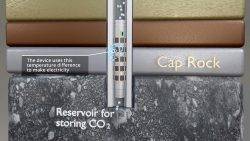
Researchers at Sandia National Laboratories recently designed, built and lab-tested a device that can use the temperature difference caused by periodically pumping carbon dioxide down a borehole to charge batteries to power underground sensors.
Capturing carbon dioxide and pumping it deep underground could be an important part of mitigating the effects of climate change. However, ensuring the carbon dioxide stays trapped away from the atmosphere, where it serves as a heat-trapping greenhouse gas, is critical. The kinds of sensors the device could power include pressure sensors, sensors to detect microseismic events, and those to monitor the health of the borehole, such as whether carbon dioxide is leaking up from the reservoir through the borehole.
“Ideally, you would have continuous underground sensing, with several different types of sensors, that would tell you how the carbon dioxide is moving, if it is reacting with the groundwater or the minerals,” said Charles Bryan, a Sandia geosciences engineer and leader of the project to develop the device. “You could demonstrate that it’s not moving out of the reservoir. However, it’s difficult to run power down a borehole: You can’t just have wires running down a working borehole.”
As heat flows from the hot earth through the device to the cooler carbon dioxide, it creates a voltage that can be used to charge a battery and eventually power sensors. The Sandia-developed device works similarly to the radioisotope thermoelectric generators used to power NASA space probes and even Mars rovers, said Ramesh Koripella, a Sandia materials scientist on the project.
While NASA’s radioisotope thermoelectric generators use the temperature difference from hot plutonium pellets and the cold of space to produce power, Sandia’s thermoelectric generator device uses the temperature difference from the hot Earth thousands of feet down and the carbon dioxide being pumped down. This technology is not nearly as efficient at producing electricity from heat as the internal combustion engine in most cars, Koripella said. However, it has no moving parts that could jam, making it ideal for hard-to-reach places such as space and deep boreholes.
The device is a multilayered tube with an array of 1-by-1-inch square thermoelectric generators, Bryan said. Each of these thermoelectric generators can turn the heat flowing through them into a voltage and then power.
The inner tube is built to withstand the temperatures and pressures from carbon dioxide being pumped through it, while the outer tube is built to withstand the temperatures and pressures from being deep underground. In the area between those two, reside the electronics to capture and convert the voltage from the thermoelectric generators to charge a battery.
Bryan added that the same thermoelectric technology could also be used to power sensors for other underground applications such as monitoring oil and gas exploration and production, but this would require periodically pumping hot or cold fluid down the borehole to maintain a temperature difference between the inside and outside of the device.
The project was funded by the Department of Energy’s Office of Fossil Energy and Carbon Management through the National Energy Technology Laboratory. The team is currently pursuing additional funding to continue their research.